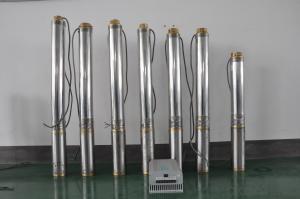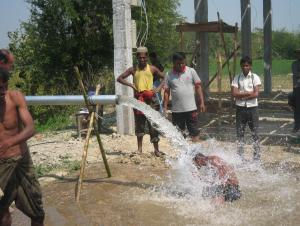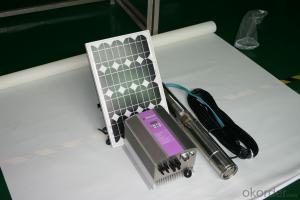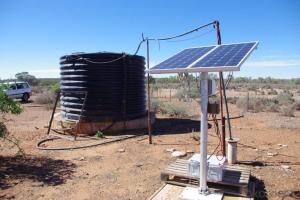solar pumping Systems
- Loading Port:
- Shekou
- Payment Terms:
- TT OR LC
- Min Order Qty:
- -
- Supply Capability:
- 100000000000000000000 pc/month
OKorder Service Pledge
OKorder Financial Service
You Might Also Like
Products
Solar Pumping System supplied by Shenzhen Solartech Renewable Energy Company(manufacturer) can be applied to daily use (ground water), agricultural irrigation, forestry irrigation, desert control, pasture animal husbandry, water supply for islands, wastewater treatment engineering, and so on. Solartech” Solar water pump System is dispensed with energy storing devices, and stores water instead of electricity. It improves the reliability of the device, at the same time, it lowers the construction and maintenance costs of the irrigation system dramatically.
In recent years, with the promotion of the utilization of new energy resources, Solar Pumping System is more and more used in municipal engineering, city centre squares, parks, tourist sites, resorts and hotels, the landscapes and fountain irrigation systems in the residential areas.
Technical Features
Optimization of Single Pump System
A single solar irrigation system consists of only one pump, a power -matched solar array and an inverter . The aim of optimization is to reduce the amount of PV modules as much as possible on the premise of filling the requirement of head and capacity. The rotational speed of pump is regulated according to the irradiation on the solar array; when the sunlight reaches its peak, the pump runs at the rated speed, and the output approaches the peak power of the solar array; when the sunlight is less abundant, the speed of pump varies bellow the range of the rated speed; when the speed as low as the capacity becomes zero, the solar pumping system stops working. So, there are big differences between solar irriation systems and traditional pumping systems in system design, and the system should be optimized according to the requirements of head, capacity, and local conditions of sunlight.
•Determine the optimal average daily operating time and the range of speed governing.
•Choose the optimal head and capacity of the pump.
•Determine the maximum power of PV modules, the best working voltage and method of connection.
Optimization of Multi-pump Systems:
There are several pumps in a multi-pump system. The pumps can be driven either by only one high-power inverter, or by several matching inverters. In the case of large capacity demand, the operation of the multi-pump system is more flexible. By switching solar arrays and pumps, all of the pumps run in MPPT mode when the sunlight is abundant, while some pumps will be shut down and all solar arrays supply power intensively for the rest running pumps when irradiation is weak. Based on the optimization of single pump system, the range of speed can be further optimized, and the photovoltaic(PV) pumping system always works with high efficiency.
Product Specifications
Model | Rated Power ( kW ) | Rated Voltage ( V ) | Head ( M ) | Daily Flow ( ㎥/ D ) |
PS370 | 0.37 | 220 | 20-47 | 20-1 |
PS550 | 0.55 | 220 | 15-70 | 40-1 |
PS750 | 0.75 | 220 | 6-81 | 100-1 |
PS1100 | 1.1 | 220 | 8-93 | 100-1 |
PS1500 | 1.5 | 220 | 7-128 | 130-1 |
PS2200 | 2.2 | 380 | 12-163 | 130-1 |
PS3000 | 3 | 380 | 9-187 | 250-10 |
PS4000 | 4 | 380 | 6-225 | 500-10 |
PS5500 | 5.5 | 380 | 10-172 | 500-20 |
PS7500 | 7.5 | 380 | 15-237 | 500-20 |
PS9200 | 9.2 | 380 | 20-140 | 500-40 |
PS11000 | 11 | 380 | 23-159 | 500-40 |
PS13000 | 13 | 380 | 27-189 | 500-40 |
PS15000 | 15 | 380 | 31-208 | 500-40 |
PS18500 | 18.5 | 380 | 39-143 | 500-100 |
PS22000 | 22 | 380 | 25-86 | 700-210 |
PS26000 | 26 | 380 | 30-105 | 700-210 |
PS30000 | 30 | 380 | 35-125 | 700-210 |
PS37000 | 37 | 380 | 40-150 | 700-210 |
PS45000 | 45 | 380 | 50-180 | 700-210 |
PS55000 | 55 | 380 | 65-200 | 700-210 |
- Q:How do you choose the right size of solar pump for your needs?
- When choosing the right size of solar pump for your needs, it is important to consider factors such as the water flow rate required, the depth of the water source, the distance the water needs to be pumped, and the power output of the solar panels. By evaluating these factors and consulting with a professional, you can determine the appropriate size of solar pump that will efficiently meet your specific water pumping requirements.
- Q:Can solar pumps be used for water supply in remote oil or gas exploration sites?
- Yes, solar pumps can be used for water supply in remote oil or gas exploration sites. Solar pumps are a sustainable and cost-effective solution that can operate independently from the grid, making them ideal for remote locations. They can effectively pump and supply water for various purposes such as drilling operations, equipment cooling, and personnel needs at these sites. Additionally, the use of solar pumps reduces the reliance on fossil fuels, minimizing the environmental impact associated with traditional water pumping methods.
- Q:How does a solar pump handle water with high levels of iron or manganese?
- A solar pump can handle water with high levels of iron or manganese by utilizing filtration systems or treatment processes. These pumps are often equipped with pre-filters or sediment removal mechanisms that can remove or reduce the iron and manganese content in the water before pumping it. Additionally, advanced solar pumps may incorporate additional treatment technologies such as oxidation or ion exchange to further manage and mitigate the levels of iron or manganese in the water.
- Q:What are the benefits of using a solar pump?
- There are several benefits of using a solar pump. Firstly, it is a cost-effective and environmentally friendly alternative to traditional pumps that run on fossil fuels. Solar pumps utilize renewable energy from the sun, resulting in reduced electricity bills and lower carbon emissions. Additionally, solar pumps are typically low-maintenance and have a longer lifespan compared to conventional pumps. They are also highly versatile and can be used for various applications such as irrigation, water supply, and livestock management, especially in remote or off-grid areas where access to electricity is limited.
- Q:How do I protect a solar pump system from pests or animals?
- There are various steps you can take to safeguard a solar pump system from pests or animals: 1. Employ physical barriers: Erect fences or wire mesh around the system to prevent animals from accessing it. Ensure that the barriers are firmly fixed and have small gaps to keep out rodents or larger creatures. 2. Use enclosures or cages: If the system is compact enough, consider placing it within a protective enclosure or cage. This will prevent animals from directly interacting with the system and causing damage. 3. Utilize pest deterrents: Employ natural or chemical deterrents to keep pests away from the solar pump system. This could involve using ultrasonic pest repellents, hanging reflective objects like CDs or aluminum foil, or utilizing environmentally safe chemical repellents that won't harm the system. 4. Conduct regular maintenance: Regularly inspect the system to ensure that pests or animals haven't inflicted any harm. Look for signs of chewed wires, nests, or any indications of animal activity. If any damage is detected, promptly take action to repair or replace the affected components. 5. Maintain cleanliness in the surroundings: Keep the area around the solar pump system clean and devoid of debris, garbage, or food sources that may attract pests. By eliminating potential food or shelter sources, you can discourage animals from gathering near the system. 6. Seek professional assistance: If the pest problem persists or if you are dealing with larger animals that pose a threat to the system, consider enlisting professional help. Pest control experts or wildlife specialists can provide tailored and effective solutions for your specific situation. By implementing these measures, you can effectively safeguard your solar pump system from pests or animals, ensuring optimal performance and longevity.
- Q:Can a solar pump be connected to existing water infrastructure?
- Yes, a solar pump can be connected to existing water infrastructure. Solar pumps are designed to be compatible with different types of water systems, including existing infrastructure. They can be integrated into the existing water supply network by connecting them to the existing pipes and valves. Additionally, solar pumps can also be used to pump water directly into storage tanks or reservoirs, which can then be connected to the existing water system. This allows for a seamless integration of renewable energy sources into the existing water infrastructure, providing a sustainable and efficient solution for water pumping.
- Q:How does the tilt angle of the solar panels affect the performance of a solar pump system?
- The tilt angle of solar panels plays a crucial role in determining the performance of a solar pump system. The optimal tilt angle ensures maximum solar energy absorption and subsequently, efficient operation of the pump. The tilt angle of solar panels affects the angle of incidence at which sunlight hits the panels. By adjusting the tilt angle, we can optimize the exposure of the panels to sunlight throughout the day and over different seasons. In general, the tilt angle should be set to match the latitude of the installation site. For example, if the location is near the equator, a tilt angle close to 0 degrees would be appropriate, while for higher latitudes, increasing the tilt angle would be necessary to capture sunlight at a better angle. When solar panels are tilted at their optimal angle, they receive sunlight more directly, increasing the amount of solar radiation absorbed. This leads to higher energy generation and better overall performance of the solar pump system. On the other hand, if the tilt angle is set too steep or shallow, the panels may not receive sunlight at the optimal angle, resulting in reduced energy production. Steep angles can cause excess shading and lower energy output, while shallow angles may result in less efficient energy absorption. Moreover, the tilt angle also affects the self-cleaning ability of the solar panels. Proper tilt angles allow rainwater to wash away dust and debris, keeping the panels clean and ensuring optimal energy generation. It is important to note that the tilt angle of solar panels can be adjusted seasonally to account for changes in the sun's position throughout the year. By optimizing the tilt angle, solar pump systems can operate at their highest efficiency, maximizing energy production and ensuring reliable pump performance.
- Q:Are solar pumps environmentally friendly?
- Yes, solar pumps are environmentally friendly. They use clean and renewable energy from the sun to power the pumps, eliminating the need for fossil fuels and reducing carbon emissions. Additionally, solar pumps have minimal environmental impact as they do not produce noise pollution or require the extraction of natural resources.
- Q:Can a solar pump be used in areas with limited access to water pumps?
- Yes, a solar pump can be used in areas with limited access to water pumps. The advantage of a solar pump is that it does not require a direct connection to the electrical grid, making it suitable for remote areas. As long as there is sufficient sunlight to power the solar panels, the pump can be utilized to extract water from underground sources or other water bodies, providing a sustainable solution for areas with limited access to traditional water pumps.
- Q:Can a solar pump be used in conjunction with a water storage system?
- Yes, a solar pump can be used in conjunction with a water storage system. The solar pump can be used to extract water from a source, such as a well or a water body, and then pump it into a water storage system for later use. This allows for the utilization of renewable energy to power the pump and ensure a reliable water supply even in areas without access to electricity.
1. Manufacturer Overview |
|
|---|---|
| Location | |
| Year Established | |
| Annual Output Value | |
| Main Markets | |
| Company Certifications | |
2. Manufacturer Certificates |
|
|---|---|
| a) Certification Name | |
| Range | |
| Reference | |
| Validity Period | |
3. Manufacturer Capability |
|
|---|---|
| a)Trade Capacity | |
| Nearest Port | |
| Export Percentage | |
| No.of Employees in Trade Department | |
| Language Spoken: | |
| b)Factory Information | |
| Factory Size: | |
| No. of Production Lines | |
| Contract Manufacturing | |
| Product Price Range | |
Send your message to us
solar pumping Systems
- Loading Port:
- Shekou
- Payment Terms:
- TT OR LC
- Min Order Qty:
- -
- Supply Capability:
- 100000000000000000000 pc/month
OKorder Service Pledge
OKorder Financial Service
Similar products
New products
Hot products
Hot Searches
Related keywords































